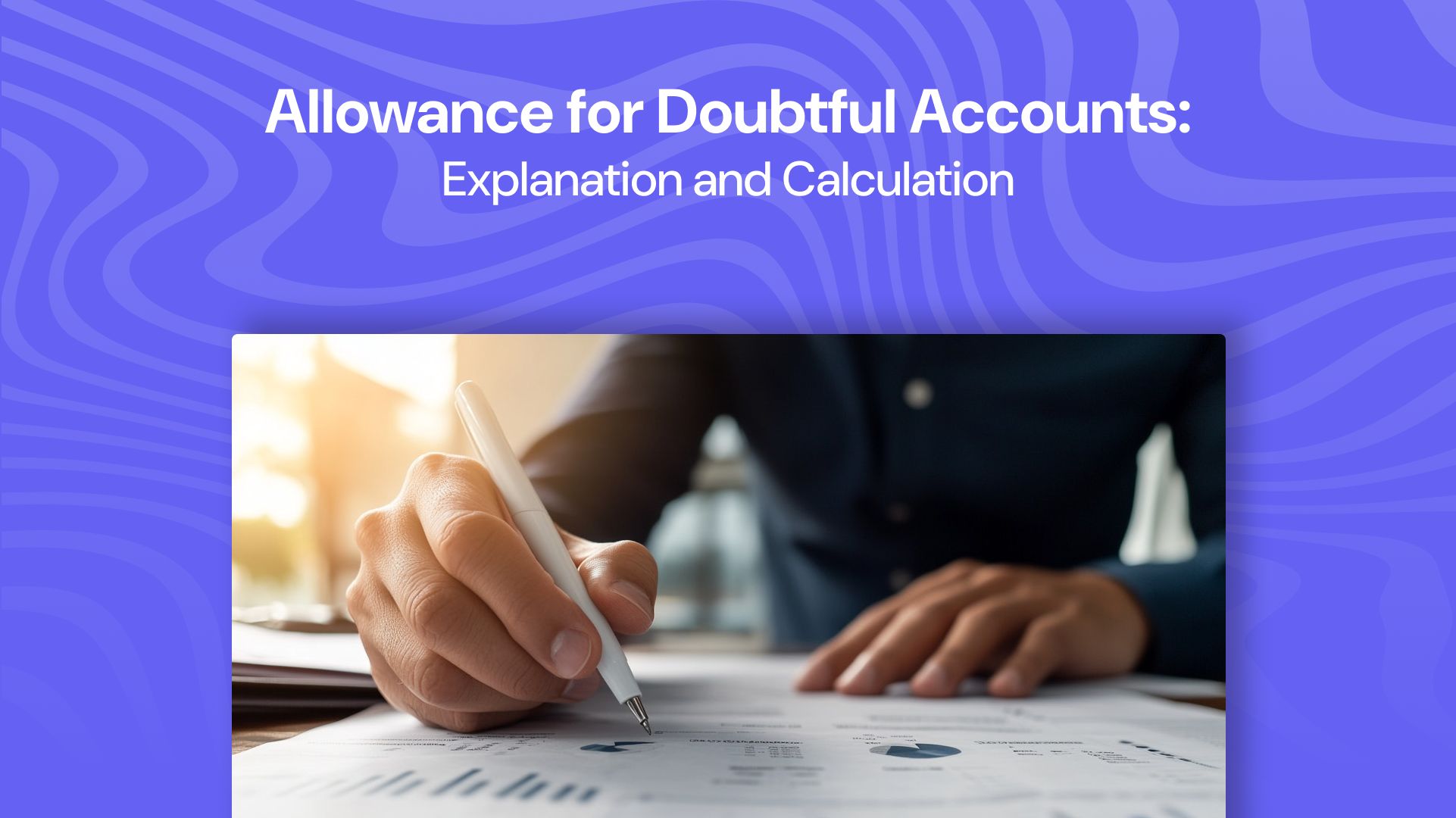Allowance for Doubtful Accounts: Explanation and Calculation

When businesses extend credit to their customers, it’s with the hope that invoices will be paid in full and on time. However, reality often paints a different picture.
According to an Atradius report, 1 in 11 invoices in the U.S. are never paid for, and it found that 55% of B2B receivables in the United States are overdue. To guard against these financial uncertainties, companies set aside a portion of their accounts receivable as an "Allowance for Doubtful Accounts."
This accounting method is crucial for maintaining accurate financial statements and ensuring businesses don’t overstate their revenue. Imagine running a company where 5% of your outstanding invoices are consistently unpaid.
Without an allowance for doubtful accounts, your financial health would appear much stronger than it actually is, leading to poor business decisions. For example, if your business has $100,000 in credit sales and you estimate that $5,000 of that will be uncollectible, you would create an allowance for that amount.
In this blog, we'll explore what the allowance for doubtful accounts really means, how it's calculated, and why it's essential for businesses to manage this risk proactively.
What is allowance for doubtful accounts?
Allowance for Doubtful Accounts is a financial accounting concept used by businesses to estimate the portion of accounts receivable that may never be collected. It’s an important tool for accurately reflecting a company's financial health by accounting for potential losses due to unpaid debts.
Instead of waiting until specific debts are confirmed as uncollectible, companies use this method to anticipate and record bad debts in the same period the revenue is recognized. This aligns with the matching principle in accounting, ensuring that revenues and expenses are recorded in the same period.
For instance, if a business has $50,000 in outstanding receivables but expects that $3,000 may be uncollectible based on historical data or economic conditions, they would set up an allowance for doubtful accounts of $3,000. This amount is recorded as a contra-asset on the balance sheet, reducing the total value of accounts receivable. The corresponding expense is logged on the income statement as a bad debt expense.
The allowance not only provides a more accurate picture of the company’s financial status but also helps businesses plan for future cash flow shortages due to unpaid invoices. By proactively managing this risk, businesses can avoid overestimating their financial strength and make more informed decisions.
Why every business should have an allowance for doubtful accounts?
In any business, unpaid invoices are an inevitable reality. A key way to mitigate this risk and ensure accurate financial reporting is through an allowance for doubtful accounts. Here’s why every business, regardless of size or industry, should have one in place.
1. Accurate Financial Reporting
Without an allowance for doubtful accounts, businesses can unintentionally overstate their assets. Imagine reporting that your company has $200,000 in accounts receivable, but in reality, 10% of those invoices will likely never be paid.
This overstatement can distort your financial statements, leading to misguided business decisions and misrepresentation to investors. By establishing an allowance, you present a more accurate picture of your financial position.
2. Better Cash Flow Management
Cash flow is the lifeblood of any company, and unpaid invoices can cause significant disruptions. A Sage study found that late payments cost U.S. businesses over $3 trillion annually in cash flow gaps. With an allowance for doubtful accounts, businesses can predict potential cash flow issues and plan accordingly, ensuring they have sufficient reserves for operations, payroll, or growth initiatives.
3. Compliance with Accounting Standards
Having an allowance for doubtful accounts helps businesses comply with the Generally Accepted Accounting Principles (GAAP) and the International Financial Reporting Standards (IFRS). Both accounting frameworks emphasize the importance of recognizing potential losses in the same period that revenue is recorded. This aligns with the matching principle, ensuring businesses are not misleading stakeholders with inflated income statements or balance sheets.
4. Proactive Risk Management
Every business faces some level of risk when extending credit to customers. By setting up an allowance for doubtful accounts, companies take a proactive approach to managing this risk, ensuring that they’re prepared for worst-case scenarios.
For instance, if you know from experience that certain customers in a high-risk sector are slower to pay, you can adjust your allowance accordingly. This measure allows for strategic planning and ensures your company isn’t blindsided by uncollectible debt.
5. Strengthening Stakeholder Confidence
A company with a well-maintained allowance for doubtful accounts shows it has a firm grasp on financial management. This increases trust and confidence among investors, lenders, and other stakeholders. Transparent reporting of potential losses, rather than ignoring them, portrays a business as responsible and forward-thinking.
Different ways to calculate allowance for doubtful accounts

When calculating the allowance for doubtful accounts, businesses have several methods to estimate potential losses from uncollectible receivables. The choice of method depends on factors like sales volume, the nature of the receivables, and historical payment behavior. Here, we explore the most commonly used techniques, each offering a unique approach to predicting and managing bad debt risk.
1. Percentage of Sales Method
This method estimates bad debt based on a fixed percentage of credit sales. Businesses typically rely on historical data to determine the percentage. For example, if a company’s past experience shows that 2% of sales become uncollectible and the company has $100,000 in sales, the allowance would be $2,000. This approach is straightforward and easy to implement, making it popular among businesses with stable sales patterns.
2. Percentage of Accounts Receivable Method
Here the focus is on the balance of accounts receivable rather than sales. Businesses apply a percentage to their outstanding receivables to estimate potential bad debts. For instance, if a company has $80,000 in receivables and expects 5% to be uncollectible, they will record an allowance of $4,000. This method is useful for companies that want a real-time view of how much they may not collect based on current receivables.
3. Aging of Accounts Receivable Method
This method categorizes receivables based on how long they’ve been outstanding and assigns a higher probability of uncollectibility to older accounts. For example, invoices that are 30 days overdue might have a 2% default rate, while those overdue by 90 days might carry a 20% rate. This granular approach allows businesses to create a more accurate allowance, especially if payment terms vary among customers.
4. Historical Experience Method
In historical experience method involves analyzing a company’s past data to estimate the allowance. For instance, if a business sees that an average of 3% of its accounts receivable have gone unpaid in the last five years, they can use this figure to predict future bad debts. This method works well for businesses with consistent customer behaviors and market conditions, making it reliable over time.
5. Specific Identification Method
In this method, businesses review their accounts receivable and flag specific customers or invoices they believe are unlikely to be paid. This approach is less about percentages and more about assessing individual risks. For example, if a particular customer has declared bankruptcy, the company may write off that account directly. It’s a targeted approach, usually used for high-risk or high-value accounts.
6. Industry Benchmark Method
In this method, businesses use industry averages or benchmarks to estimate their allowance for doubtful accounts. This approach can be helpful for new companies or those without enough historical data. For instance, if industry data shows that businesses in a particular sector typically experience a 3% default rate, a company in that industry might apply the same percentage to its receivables.
7. Macroeconomic Forecasting Method
The macroeconomic forecasting method takes into account broader economic conditions, such as inflation, recession, or changes in customer behavior during downturns. Businesses use economic indicators to adjust their allowance estimates based on the potential impact on their customers’ ability to pay. For example, during an economic downturn, a company may increase its allowance percentage to reflect an expected rise in default rates.
8. Pareto Analysis Method
The Pareto Analysis Method, often referred to as the 80/20 Rule, is used to identify and focus on the most significant receivables that are likely to become bad debt. In this approach, businesses recognize that roughly 80% of uncollectible accounts may come from 20% of their customers. By applying this method, companies can prioritize monitoring and creating allowances for higher-risk clients or transactions.
Example of an allowance for doubtful accounts
A company, XYZ Corp., has total accounts receivable of $150,000 at the end of the fiscal year. Based on historical data and industry benchmarks, the company estimates that 5% of its receivables might be uncollectible.
Calculation:
- Estimate the allowance:
Estimated Allowance = Total Accounts Receivable×Estimated Percentage = $150,000×5% = $7,500
- Set Up the Allowance: The company will record an allowance for doubtful accounts of $7,500 in its financial statements. This is done by creating a contra-asset account on the balance sheet, which offsets the total accounts receivable.
- Record the Adjusting Entry: In the general ledger, XYZ Corp. would make an adjusting journal entry to account for the estimated bad debts:
Bad Debt Expense (Income Statement) = $7,500
Allowance for Doubtful Accounts (Balance Sheet) = $7,500
Impact:
- Balance Sheet: Accounts receivable will appear as $150,000, but the net amount expected to be collected will be $142,500 ($150,000 - $7,500).
- Income Statement: The bad debt expense of $7,500 will be recorded as an expense, reducing the company’s net income for the period.
This example demonstrates how the allowance for doubtful accounts provides a more accurate picture of expected cash flows and helps in financial planning and reporting.
Different ways to calculate allowance for doubtful accounts

Maintaining journal entries for the allowance for doubtful accounts involves recording the estimated uncollectible amounts and adjusting them as necessary based on actual collection outcomes. Here’s a step-by-step guide on how to handle these entries:
1. Establishing the Allowance
When you initially estimate the allowance for doubtful accounts, you record an adjusting journal entry to account for anticipated bad debts.
Journal Entry:
- Debit: Bad Debt Expense
- Credit: Allowance for Doubtful Accounts
Example: If you estimate an allowance of $7,500:
2. Writing Off Uncollectible Accounts
When a specific account is determined to be uncollectible, you need to write off the amount against the allowance.
Journal Entry:
- Debit: Allowance for Doubtful Accounts
- Credit: Accounts Receivable
Example: If a $1,000 receivable is deemed uncollectible:
3. Recovering Previously Written-off Accounts
If an account that was previously written off is later collected, you need to reverse the write-off and record the collection.
Journal Entries:
- Reverse the Write-Off:
- Debit: Accounts Receivable
- Credit: Allowance for Doubtful Accounts
- Record the Collection:
- Debit: Cash
- Credit: Accounts Receivable
Example: If a previously written-off $500 account is collected:
4. Adjusting the Allowance
At the end of the accounting period, you may need to adjust the allowance based on a new estimate or changes in collection experience.
Journal Entry:
- Debit/Credit: Allowance for Doubtful Accounts (adjust to new estimate)
- Credit/Debit: Bad Debt Expense (if increasing allowance) or Recoveries (if decreasing allowance)
How can FinanceOps help you in reducing allowance for doubtful accounts?
FinanceOps can significantly help in reducing the allowance for doubtful accounts through its advanced features and AI-driven capabilities. By leveraging Genesis One, FinanceOps provides a comprehensive solution for managing financial operations, including debt collection.
1. Enhanced Risk Assessment: FinanceOps utilizes AI to analyze customer creditworthiness and payment histories more accurately. This data-driven approach allows businesses to better assess the risk associated with extending credit, thereby reducing the likelihood of defaults. With more precise risk assessments, companies can lower their estimated allowance for doubtful accounts.
2. Automated Collections: FinanceOps automates the collection process through its autonomous collections feature. This includes sending timely reminders and following up on overdue invoices without manual intervention. Automated collections reduce the incidence of overdue accounts and improve cash flow, directly impacting the need for a high allowance for doubtful accounts.
3. Advanced Reporting and Analytics: The platform offers detailed insights and reporting tools that track payment trends and identify potential issues early. By monitoring these metrics, businesses can proactively address collection challenges and adjust their allowances based on real-time data, leading to more accurate and potentially lower allowances for doubtful accounts.
Incorporating FinanceOps into your financial operations helps streamline collections, improve risk management, and ultimately reduce the financial buffer needed for uncollectible accounts.
FAQs
1. What is the purpose of the allowance for doubtful accounts?
It estimates the portion of accounts receivable that may not be collected. It ensures financial statements reflect a more accurate picture of a company's assets by accounting for potential losses. This method aligns with the matching principle in accounting, where revenues and related expenses are recorded in the same period, providing a realistic view of net income and financial health.
2. How is the allowance for doubtful accounts calculated?
Allowance for doubtful accounts can be calculated using methods like percentage of sales, percentage of accounts receivable, aging of accounts receivable, or historical experience. Each method involves estimating uncollectible amounts based on historical data, customer credit risk, or industry benchmarks. The chosen method depends on the company’s data availability and risk management practices, providing a buffer against potential losses from unpaid invoices.
3. When should the allowance for doubtful accounts be adjusted?
Allowances should be adjusted at the end of each accounting period based on changes in receivables and collection experience. Adjustments are necessary if new data or economic conditions indicate a higher or lower risk of uncollectibility. For instance, if a company’s overdue receivables increase significantly or if there’s a change in customer payment behavior, the allowance may need to be increased or decreased accordingly.
4. How does writing off an account affect the allowance for doubtful accounts?
When an account is deemed uncollectible, it is written off by debiting the allowance for doubtful accounts and crediting accounts receivable. This action reduces both the receivables and the allowance balance, reflecting the actual loss. The write-off does not impact the income statement directly since the expense was previously recorded, but it adjusts the allowance balance to more accurately match the expected losses.
5. Can the allowance for doubtful accounts be reversed?
Yes, the allowance for doubtful accounts can be reversed if a previously written-off account is collected or if the estimated uncollectible amount decreases. To reverse a write-off, you would debit accounts receivable and credit the allowance for doubtful accounts. Upon collection, debit cash and credit accounts receivable. This process ensures the allowance remains accurate and reflects current receivables and their collectibility status.

